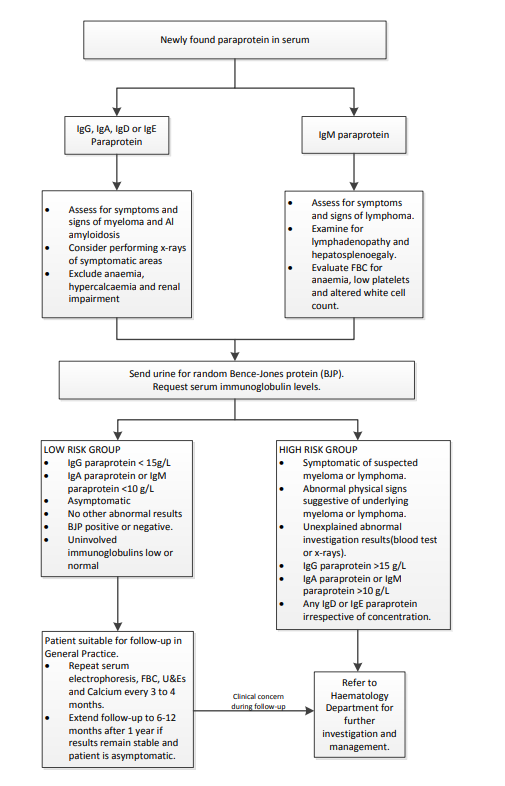Makindo Medical Notes"One small step for man, one large step for Makindo" |
|
|---|---|
| Download all this content in the Apps now Android App and Apple iPhone/Pad App | |
| MEDICAL DISCLAIMER: The contents are under continuing development and improvements and despite all efforts may contain errors of omission or fact. This is not to be used for the assessment, diagnosis, or management of patients. It should not be regarded as medical advice by healthcare workers or laypeople. It is for educational purposes only. Please adhere to your local protocols. Use the BNF for drug information. If you are unwell please seek urgent healthcare advice. If you do not accept this then please do not use the website. Makindo Ltd. |
Monoclonal gammopathy Undetermined significance
-
| About | Anaesthetics and Critical Care | Anatomy | Biochemistry | Cardiology | Clinical Cases | CompSci | Crib | Dermatology | Differentials | Drugs | ENT | Electrocardiogram | Embryology | Emergency Medicine | Endocrinology | Ethics | Foundation Doctors | Gastroenterology | General Information | General Practice | Genetics | Geriatric Medicine | Guidelines | Haematology | Hepatology | Immunology | Infectious Diseases | Infographic | Investigations | Lists | Microbiology | Miscellaneous | Nephrology | Neuroanatomy | Neurology | Nutrition | OSCE | Obstetrics Gynaecology | Oncology | Ophthalmology | Oral Medicine and Dentistry | Paediatrics | Palliative | Pathology | Pharmacology | Physiology | Procedures | Psychiatry | Radiology | Respiratory | Resuscitation | Rheumatology | Statistics and Research | Stroke | Surgery | Toxicology | Trauma and Orthopaedics | Twitter | Urology
Related Subjects: |Hypercalcaemia |Multiple Myeloma |Extramedullary Plasmacytoma |Smouldering Myeloma |MGUS |Waldenstrom Macroglobulinaemia |Oncological emergencies
🧪 Monoclonal Gammopathy of Undetermined Significance (MGUS) is a benign paraproteinaemia defined by a serum monoclonal protein < 30 g/L, < 10% plasma cells in the marrow, and no end-organ damage (CRAB: hyperCalcaemia, Renal failure, Anaemia, Bone lesions). The key differentiating feature from myeloma is the absence of complications such as immune paresis, hypercalcaemia, renal impairment, or bone disease.
📖 About
- MGUS is a paraproteinaemia that may progress to myeloma.
- Serum monoclonal protein < 30 g/L, plasma cells < 10%.
- Progression to myeloma may take years (≈1% per year risk).
📊 Epidemiology
- Asymptomatic and very common in older adults.
- ~1% prevalence over age 25, 3% >70 yrs, 10% >80 yrs.
- Only ~25% of cases progress to myeloma.
🔎 Differential Diagnosis of a Monoclonal Band
- 🦴 Multiple Myeloma: Bone pain, lytic lesions, hypercalcaemia, renal disease.
- 🧬 Lymphoma: Lymphadenopathy, hepatosplenomegaly.
- 🧪 Chronic Lymphocytic Leukaemia (CLL): Raised lymphocyte count.
- 🟢 MGUS: Asymptomatic, low paraprotein, no CRAB features.
⚡ Clinical Features
- Typically none due to MGUS itself.
- No bone pain or recurrent infections.
- 10–30% may have a demyelinating neuropathy.
🚫 In MGUS there is NO:
- Bence-Jones proteinuria.
- Lytic bone lesions.
- Hypercalcaemia.
- Renal insufficiency.
- Anaemia.
- Monoclonal Ig level > 30 g/L.
- Plasma cells > 10% on bone marrow exam.
- Immunoparesis (suppression of other Ig classes).
📈 Risk of Progression
- ~1% of patients progress to myeloma each year.
- Risk factors for progression include paraprotein type and level, and serum free light chain ratio.
🧮 Risk Stratification – “Mayo Model”
- Paraprotein > 15 g/L ➕ 1 point.
- Abnormal free light chain ratio ➕ 1 point.
- Non-IgG paraprotein (IgA, IgM, IgE) ➕ 1 point.
📊 20-Year Risk of Progression
- 0 factors → 5%.
- 1 factor → 21%.
- 2 factors → 37%.
- 3 factors → 58%.
🧾 Management
- Low-risk MGUS (0–1 risk factors) can be managed in primary care.
- Follow-up every 6–12 months:
- History: weight loss, night sweats, bone pain.
- Examination: lymphadenopathy, hepatosplenomegaly.
- Tests: FBC, calcium, creatinine, albumin, SPE with paraprotein quantification.
- Refer to haematology if:
- Lymphadenopathy.
- Significant paraprotein rise (>25% & absolute rise >5 g/L).
- New cytopenias (anaemia, neutropenia, thrombocytopenia).
- Renal impairment or new bone pain.

Cases — MGUS (Monoclonal Gammopathy of Undetermined Significance)
- Case 1 — Incidental Finding in the Elderly: A 72-year-old man has routine bloods before cataract surgery. Serum protein electrophoresis shows a small monoclonal IgG kappa paraprotein (12 g/L). Hb, calcium, creatinine, and skeletal survey are normal. He is asymptomatic. Diagnosis: MGUS, requires monitoring for progression.
- Case 2 — Workup for Anaemia: A 65-year-old woman is investigated for mild normocytic anaemia. SPEP reveals a monoclonal IgA lambda band of 18 g/L. Bone marrow biopsy shows plasma cells <10%. No lytic lesions, renal impairment, or hypercalcaemia. Diagnosis: MGUS, not myeloma.
Teaching Commentary 🧬
MGUS is a benign clonal plasma cell disorder defined by: - Serum monoclonal protein <30 g/L, - <10% plasma cells in bone marrow, - No CRAB features (hyperCalcaemia, Renal impairment, Anaemia, Bone lesions). It is common in older adults (≈3–5% over age 70). MGUS is usually asymptomatic but carries a risk (~1% per year) of progression to multiple myeloma or related disorders. Management: no treatment, but regular monitoring with FBC, renal function, calcium, and paraprotein levels to detect progression early.